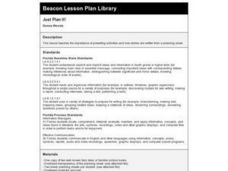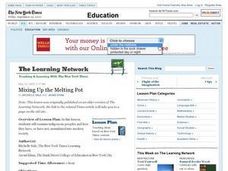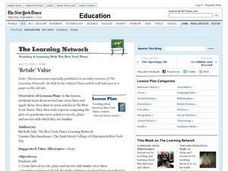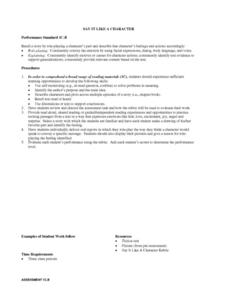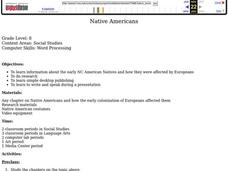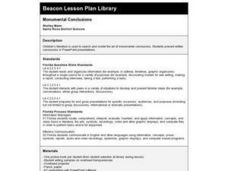Curated OER
The Rest of the Story
Third graders make predictions about the story "The True Story of the Three Little Pigs" based on background knowledge. They read the story, stopping to verify or reject predictions. They write their own opinionated fairytales.
Curated OER
Early Attempts at Flight
Students investigate the early history of flight. In this aviation history instructional activity, students are split into six groups to research the development of the ornithopter, hot air balloon and the glider. Each group records...
Curated OER
Discover Your World
Fifth graders, in groups, locate a place on a map where the group would like to visit, research the place then write a complete report on the outcome of the findings. They groups must make a cooperative oral presentation to the class.
Curated OER
Charlie and the Chocolate Factory
Fourth graders research and write an author report on Roald Dahl, including books written by him, birthplace, family life, and other information on his writing. Students read aloud chapters in the book. Students create a newspaper...
Curated OER
My Favorite Things
Pupils identify "masterpieces" and mass-produced objects. They explain why they value a given object and determine what physical materials were used to create the objects. They create a class book featuring objects that they value.
Curated OER
Just Plan It!
Fourth graders practice using a planning sheet for a well-known fairy tale or picture book.
Curated OER
Inventor's Project
Students conduct research about different inventors and their inventions. They use various types of resources to obtain information. Students use the information to create a class museum that contains artifacts, written reports, or models.
Curated OER
Smoses Toy Expo
Students research one of the simple machines listed in the lesson and review several simple machine websites to complete their research. Students use software and a watch a video to learn more about machines. Students create a poster...
Curated OER
Tom Sawyer
Students compare and analyze the relationship between Mark Twain's background and what they believe to be true about the book Tom Sawyer.
They apply correct sentence and paragraph construction in their writing.
Alabama Learning Exchange
Men and Women of Space Exploration
Fourth graders research famous astronauts. In this space science instructional activity, 4th graders list famous astronauts and use reference materials and the Internet to write a report on them.
National First Ladies' Library
Designing the Common School: The First Educational Reform
Middle schoolers perform preliminary research to explore education before public (common) education was in place. They design a public educational system of their own. Students construct a report outlining challenges and solutions for...
Curated OER
Mini-Ecosystems
Third graders identify the living and non living things in a book read aloud and discuss the interactions represented in the book. Then, they research and include a list of food that each animal needs in an ecosystem. Finally, 3rd...
Curated OER
Mixing Up the Melting Pot
Students examine the cultures of indigenous peoples and how they have or have not assimilated into modern society. They create reports with recommendations on how the Nukak of Columbia could be assimilated into society.
Curated OER
Life On The Oregon Trail
Students investigate the concept of the Oregon Trail. They conduct research using a variety of resources. The class divides into different groups to take a different aspect of the research. Then the groups present the findings to the...
Curated OER
NIMBY...Settlement...This Is The Place
Fourth graders identify the discussions, disagreements, and resolutions that zoning or location decisions can create. They explain how NIMBY (NOT IN MY BACK YARD) works and how the desires of the individual and the group affect the NIMBY...
Curated OER
How Does It Move?
Students listen to the song, The Wheels on the Bus. They attempt to sing the song again, but change it for a tractor. They watch the book, A Visit With Grandma, through a projector, LCD panel, or big screen television and develop their...
Curated OER
"Retale" Value: Exploring Plot Similarities in Fiction and Nonfiction Stories
Students explore seven basic story lines and apply these story lines to news articles in the New York Times. They write reports comparing the plot of a news article to novels, plays and movies with which they are familiar.
Curated OER
Enduring Legacies of the New Deal
Students investigate U.S. history by listening to an economics lecture. For this U.S. government lesson, students research the "New Deal" which happened after the Great Depression. Students identify movies, books and music from the...
Curated OER
Say It Like A Character
Young scholars read a story and retell it to the class by role-playing one of the characters. In groups, they use the correct facial expressions along with body language and voice to convince the others in their group that they are...
Curated OER
Native Americans
Eighth graders are assigned a group of Native Americans from the North Carolina area to study. They research and write a paper, including sections on family, government, food, clothing, shelter, European contact, artifacts and give an...
Curated OER
Internet Exploration of San Francisco
Students use the Internet for gaining information on a specific topic.
They identify a specific place or event in San Francisco history.
They summarize topic findings into a report to present to a small group and
also to be...
Curated OER
Historical Fiction: Persuasive Presentation
Fifth graders read a book addressing a specific historical time period that was chosen by their working group. They complete journal entries as they read the book. They create a group PowerPoint explaining the personal point of view and...
Curated OER
Monumental Conclusions
Fourth graders create a PowerPoint presentation comparing a "Grabless Conclusion" to a "Monumental Conclusion", using picture books.
Curated OER
Look at Philanthropy in Children's Literature
Students listen to stories about different philanthropic acts. They work together in groups to create a list of the needs of their community. They chose a service project which could be completed by their class.







